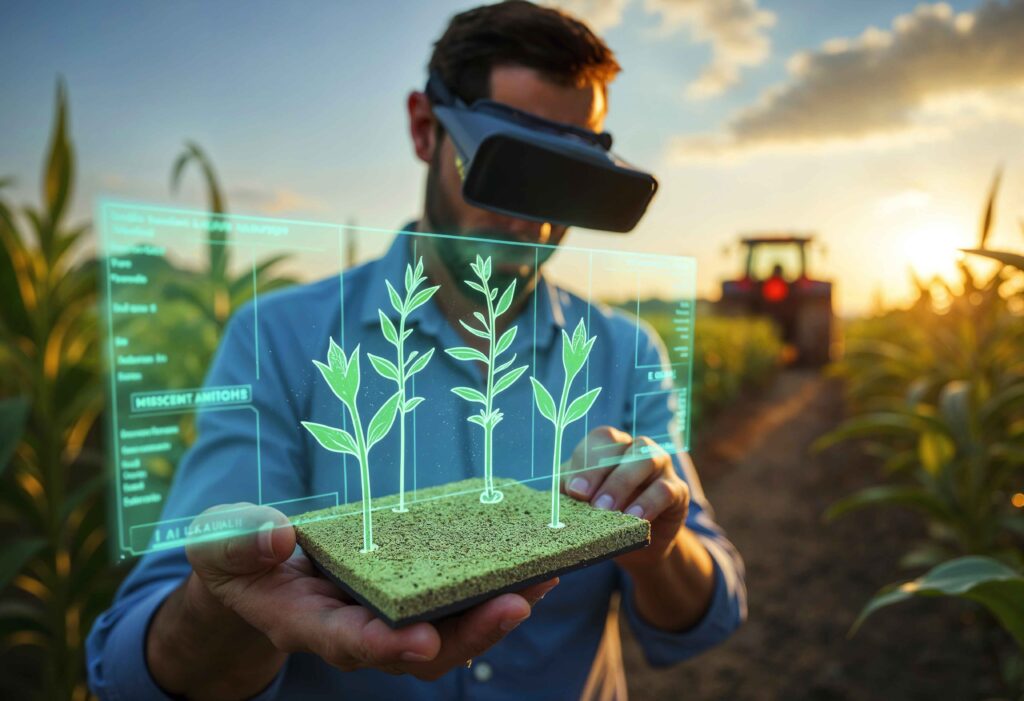Technology is now the primary driver of productivity in agriculture rather than merely a supplementary tool. Equipment driven by artificial intelligence (AI) is one of the developments transforming the sector.
By combining machine learning, data analytics, and smart sensor algorithms into agricultural equipment, Artificial intelligence (AI) is assisting farmers with machinery in Agriculture, in increasing productivity, making decisions based on data, increasing yields, and lowering expenses and their effects on the environment.
Comprehending AI-Powered Machinery in Agriculture
Machinery in agriculture that employs artificial intelligence algorithms to carry out tasks independently or with little assistance from humans is referred to as AI-powered machinery.
These devices use a variety of sensors to measure the soil’s temperature, moisture content, and nutrient levels.
- GPS and IoT connectivity (for location-based precision)
- Drones (for crop imaging and monitoring)
- Models for machine learning (for data analysis and forecasting)
Drones for crop monitoring, AI-driven irrigation systems, robotic harvesters, and autonomous tractors are a few examples. Unlike traditional instruments, digital automation extracts knowledge from data, improves over time, and adjusts to shifting field conditions.
Important Uses in Agriculture
1. Precision Planting AI-enabled planting devices
These pinpoint the precise location, depth, and spacing of seeds by utilizing soil data, topography, and historical yield maps. It uses resources like water and fertilizers without wasting them, and also ensures that all seeds grow evenly.
2. Automated Irrigation: AI-driven irrigation systems
By monitoring the weather, soil water levels, and development stages, it conserves water. It overall enhances the yield because when the perfect amount of water is given to fields, it improves their health.
3. Control of Weeds and Pests
High-resolution cameras with AI capabilities identify weeds in crops, and the intelligent sprayer applies pesticides to the weed-infested areas. In this way, it detects the early symptoms of disease, which the human eye is unable to detect. Thus, it can limit the use of chemicals and lessen the demand for pesticides.
4. Self-governing Harvesters and Tractors
Nowadays, there are auto tractors and harvesters that do tasks accurately, locatefields, and optimize routes. These tools reduce the demand for labor from humans and work effectively even for extended periods.
5. Crop Monitoring and Yield Prediction
AI drones now take pictures and monitor the health of fields and determine nutritional deficiency through routine examinations. This makes it possible for farmers to take proactive steps before problems get worse.
AI-Powered Farm Equipment’s Advantages
1. Enhanced Productivity
AI-powered solutions lower labor expenses and save time. Therefore, it can be profitable in the long term and also avoid a lot of stress because everything has been made easier by technology, including irrigation and sowing.
2. Cutting Expenses
By using machinery in agriculture, we can avoid waste and unnecessary expenses by using seeds, water, and fertilizers more effectively for the specific region in which they are utilized.
3. Increased Production
Making decisions based on data guarantees that crops are given the best growing conditions, which increases productivity.
4. Sustainability of the Environment
Applying chemicals and water precisely reduces pollution in the environment and encourages sustainable farming methods.
5. Fewer Labor Difficulties
AI-powered machinery in agriculture can cover the labor shortage in rural areas, which is becoming a global issue, and maintain levels of production.
Real-World Examples
1. John Deere’s Autonomous Tractor
This machinery in agriculture is a true example of technology with advanced GPS, sensors, and the latest AI algorithms. This AI-powered tractor performs operations without a driver. This tractor is operated in many developed countries.
2. Blue River Technology’s See & Spray System
Uses AI cameras to identify weeds and cut down on pesticide use by up to 90%, only applying herbicide where needed.
3. Naïo Technologies’ Robot Machinery in Agriculture
AI robots monitor the crops independently, helping large farms to reduce labor and other expenses and the need for large amounts of chemical herbicides.
4. Smart Irrigation in Israel
The well-known AI-powered irrigation system Netafim observes soil and other parameters like wind speed and temperature for perfect water usage. Thus, it benefits the water shortage regions.
Challenges in Adopting AI Machinery in Agriculture
Despite a large number of advantages, there are a few hurdles that prevent its adoption. For small farmers, it is difficult to adapt because its initial cost is high. Operating and maintaining of AI machinery requires training. AI skills that depend on the immediate transfer of data may be difficult to fully employ in rural locations with inadequate internet access.
Conclusion
AI-powered machinery for agriculture is producing high crop yields and remarkable productivity benefits. It not only saves labor costs but also water, fertilizers, and chemical usage.
It is eco-friendly by reducing waste. Governments and institutions in developed countries, such as China and the United States, are investing more funds in this technology to achieve significant results. For those involved in farming and agriculture, it’s a good time to take action for remarkable change.



Very good article
[…] AI-Powered Machinery in Agriculture: Revolutionizing Modern Farming […]
[…] AI-Powered Machinery in Agriculture: Revolutionizing Modern Farming […]
[…] AI-Powered Machinery in Agriculture: Revolutionizing Modern Farming […]